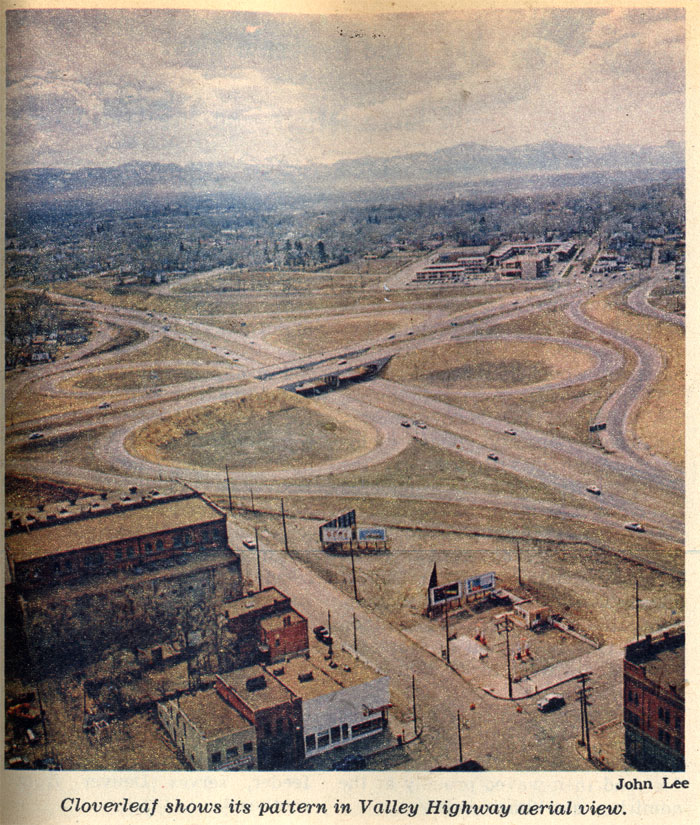
A Cloverleaf on the Valley Highway in 1959
The Story of Denver traffic —100,000 cars in 1945 and 200,000-plus today
In Denver in the early Twentieth Century water wagons to keep down the dust were an institution. In the 1930’s road oil was sprayed on many streets to keep down the dust and thus eliminate the water wagons. By the start of World War II Denver had a fairly good street system, adequate for the traffic, and attractive in its tree-lined setting.
The wartime and post-war boom unhinged a lot of things in Denver, but streets most of all. The road oil streets flew to pieces. There hadn’t been much for the oil to mix with—they were almost useless against heavy traffic.
But this was just one part of the problem. One-way street systems had to be installed on a wholesale basis, traffic control systems had to be revised, new routings became essential and planning, in general, had to leap ahead by years.
Mayor Quigg Newton, whose regime coincided with these early days of stirring growth, led the fight for another phase: the Valley Highway. This great system, knifing across the city southeast to northwest, was completed in late 1958. It has brought the Twentieth Century to Denver more than any other public work. Motorists can speed across the city in about one-half hour, or go to work downtown from a suburban residence in 20 minutes.
Denver citizenry was at first shocked by the swiftly changing traffic surgery brought on by growth, things like the “anyway-walk” system to allow pedestrians full use of each intersection during their own phase of the stop light.
But no one has questioned the need for all this. It’s been startling: 100,000 cars in Denver in 1945—205,000 in 1959. And this doesn’t even count the mushrooming suburbs.
Note: Text and image from “This is Colorado – a special centennial magazine section of the Denver Post, June 21st, 1959”

At first look I assumed this was the mousetrap, but maybe it is Colfax as Hugh suggested. The CDOT actually counts cars and if I’m reading the tables correctly the average daily traffic at the Colfax exchange is 206,000 cars a day!
http://www.dot.state.co.us/
When my boyfriend and I rode a bus downtown to go to a movie — we’d walk along the Denver streets looking in shop windows. At an intersection, we’d wait for a signal to walk diagonally from one corner to another across both streets. “The Barnes Dance.” He explained that Barnes
had come to Denver to make traffic go more smoothly, and so, in Denver we had the “Barnes Dance.” Just a few weeks ago, on a visit to a pizza place in Downtown Littleton, the old geezer
commented to me again, — “Look, they have the Barnes Dance here.” (As we watched a couple
angle across the intersection of Prince and Main.)
Thanks for the memories.
Yes, the barnes dance is a great denver story – one that we’re hoping to feature in a future post.
Thanks for the feedback!
-Hugh
When I-70 was completed, my family lived in north Denver near the original Elitch Gardens (my mom still lives there.) My dad was a chemist at the Rocky Mountain Arsenal (now a superfund site/nature preserve). He remembered taking the new highway at seven in the morning for the first time — heading east, taking, I imagine, the Lowell Blvd. or Tennyson on-ramp, on the new highway to the Havana exit. His was the only car in sight.
Needless to say, this changed.
I’m almost positive that picture is looking southwest over Speer Blvd. The hotel and gas station on the upper right are still there.
Fred, I think you are right. Good eye! That’s the denver tramway/forney museum/REI on the bottom left. The building that is now brothers bar was two stories then, that threw me off.
Thanks!
-Hugh
Fred, I can’t believe i didn’t see it before, it’s so clear now that I see it!
Would the hotel be the old Continental (at the top of the picture)?